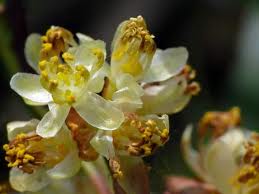Laurus
|
This slow growing, evergreen tree is often grown as a shrub; it is commonly called Bay, Bay Laurel, and Sweet Laurel. Bay can live as a woody houseplant for many years. It is a native of the Mediterranean region and isn't hardy in the North. Its shiny, dark green, fragrant leaves were once twined into wreaths by the ancient Romans and Greeks and were used to crown the champions in their sports and wars. This tree may grow 30 feet or more high, where temperatures stay above 20 degrees in the winter. In Europe it can reach a 60-foot height if grown under the best conditions. It may be cultivated in large tubs and pruned into the shape of a pyramid or a globular head atop a stem of several feet. Male and female flowers grow on different trees and black berries follow the latter. The leaves contain an essential oil, which is sometimes used in the manufacturing of perfumes. Whole leaves are used for flavoring and other culinary purposes.
Pot CultivationThis tree flourishes in well-drained, loamy soil in a position in full sun. It needs protection from frost and cold drafts. They should be fed and watered sparingly throughout the winter. When the plants reach 12 to 18 inches high, snip off mature leaves once in a while for fresh use or to dry. To keep plants growing, never take more than a third of the leaves. PropagationThe best way to increase Bay is to use rooted cuttings taken from the first shoots of early summer growth. Use a pot with a top diameter about 75 percent (and no larger) of the height of the tree.
VarietiesL. nobilis. |





